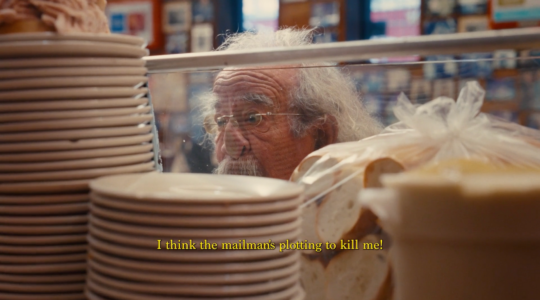The ìlast remnantsî of the Lower East Side?Holly Kaye, founding executive director of the Lower East Side Conservancy and now its consultant, was taken aback reading those words in the Associated Press story about the collapsed roof of the First Roumanian-American Congregation on Rivington Street.
Yes, that shulís building, first built in 1857 and a shul since 1902 looked like it might not survive; its 1,700 seat main sanctuary ó once known as the Cantorís Carnegie Hall ó was mildewed and rotting, its pews askew, unused for regular services long before the roof caved in on Jan. 23.
But thatís not typical of Lower East Side synagogues, said Kaye. Other than First Roumanian, there are nearly two dozen active synagogues on the Lower East Side and its adjacent neighborhoods, serving a Jewish population of 52,900 and rising, as of 2002.ìItís not what it was 100 years ago; everyone recognizes that,î said Kaye. ìBut itís also not a dying neighborhood either. Thereís been a renaissance.î Her group helped fuel that renaissance, pumping more than $2 million into synagogue conservation since the Conservancyís founding in 1997.
Much of the Conservancyís money comes from a keen understanding of how much government and philanthropic money is out there, earmarked for landmarks. But First Roumanian congregants tell how the shul was uncomfortable with the idea of being landmarked and having to answer to landmark guidelines. The shul was also uncomfortable with suggestions that, like some other neighborhood shuls, it turn its unused area into a museum of past glory, as did the Eldridge Street Project, or an arts and concert hall, as did the Orensanz Center. Both Eldridge and Orensanz continue to house prayer services in side rooms, as did First Roumanian ó Eldridge Street daily, and every other Shabbat at Orensanz.But Ira Keller, a longtime congregant at First Roumanian, said, ìI want to know that when I come into a shul I donít have to answer to anyone but God. If this was landmarked and that sort of thing, everybody would be coming in with their opinions, people with the money would be saying do this, do that. Here we know the way the rabbi taught us: Weíre in charge.îSeveral weeks after the roof collapsed, ìthe insurance company is playing hardball,î said Rabbi Shmuel Spiegel, spiritual leader of First Roumanian, and the one who spoke to reporters about ìthe last remnants.î Does he regret not working closer with the Conservancy? ìYou look backwards, you go backwards,î said the rabbi. ìA lot of things could have happened, should have happened. I have to look forward.î The shul that once seated 1,700 is now conducting services in Rabbi Spiegelís motherís living room on Grand Street. According to the Conservancy, First Roumanian, because of its hesitation, only received $7,500 while other synagogues received almost 20 times more.
The much smaller Stanton Street Synagogue, a congregation that went to court in 2002 to beat back an attempt by its rabbi to fold the congregation and sell the less-than-sound building, has since received $141,202 through the Conservancy. The revitalized shul now draws 100 to 150 people to many of its events and has embarked on restorations and structural repair.Over on Broome Street, Kehila Kedosha Janina, a vest pocket of a shul thatís no wider than a two-car garage, a shul that has only Shabbat services whereas First Roumanian had a daily minyan, received $140,000 from New York Stateís Landmark Conservancy Sacred Sites Historic Properties and the Office of Parks, Recreation and Historic Preservation. Assembly Speaker Sheldon Silver, who davens at the Lower East Sideís thriving Bialystoker Shul ó where there are five daily minyans and 200 congregants on Shabbat ó recently presented Janina with a $50,000 check to help pay for a new roof and repair of masonry and stained glass windows. Marcia Haddad Ikonomopoulos, director of the modest but intriguing Janina museum celebrating the congregationís Greek origins, said the shul ó designated as an official landmark in 2004 and featured in a recent documentary at the Sephardic Jewish International Film Festival ó is now planning to overhaul its electrical system and replace its fluorescent lights with fixtures more evocative of the synagogueís original look. She said, ìWe owe a great deal to the Lower East Side Conservancy, helping us with grant proposals and reaching out to a larger audience.î
Joel Kaplan, executive director of the United Jewish Council of the Lower East Side, the Conservancyís parent organization, pointed out that several synagogues have been revitalized with private funding. Chasam Sopher, a congregation on Clinton Street, recently finished a $3 million restoration, restoring the look of the 1853 building to its early splendor. The philanthropist behind the restoration, Hank Sopher, who says he is a relative of the 19th- century scholar known as the Chasam Sopher, did have some strings attached to his generosity. He told The Jewish Week that he wanted the shul to be open to the community, without membership dues or even fees from those whoíll use the shul for a wedding or other Jewish events. Kaplan said the next gleam in the Conservancyís eye is the structural redemption of Beth Hamedrash Hagadol on Norfolk Street.A fire in 2001, said Kaye, left the massive 1,400-seat Gothic Revival sanctuary ìso drenched we were convinced we were going to lose the whole ceiling.îSeveral blocks away from First Roumanian, the Conservancy has raised more than $800,000 toward a multimillion- dollar revival of Beth Hamedrash Hagadol, hoping to create a new Lower East Side visitors center and exhibition space.
Back in 1967, its spiritual leader Rabbi Ephraim Oshry, famous for his religious leadership in the Kovno Ghetto, was perhaps the first rabbi on the Lower East Side to see the potential benefits in landmarking and utilizing the synagogueís history to help perpetuate the shul into the future.The shul has since been designated as one of the Ten Most Endangered Sacred Places by the National Partners for Sacred Places ó the only synagogue on the list.Kaplan said, ìWe have preservation architects and engineers on board, weíll secure the roof and the heating and ventilation systems, preserve the murals and the look of the shul and have space set aside for exhibits, programs and a visitors center, along with new office space for the Conservancy. We intend to preserve the minyan downstairs, where it davens now, while looking for a bíkovodik [honorable and respectful] way to preserve the building.îìWe canít lose these spaces,î added Kaye.From Broome to Grand to Norfolk Streets, these spaces are more alive, and more sound, than theyíve been in years. The rain stays out. Over on Rivington Street, the shul is open to the sky. n
The New York Jewish Week brings you the stories behind the headlines, keeping you connected to Jewish life in New York. Help sustain the reporting you trust by donating today.




